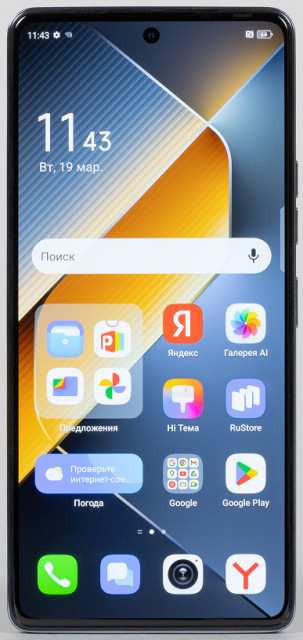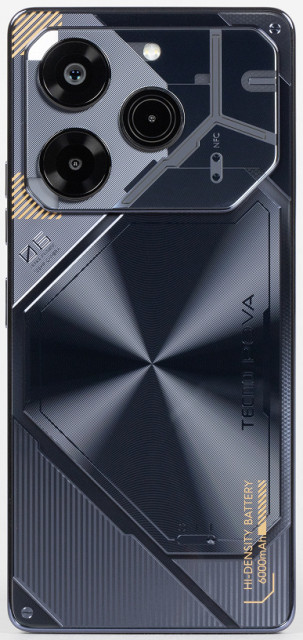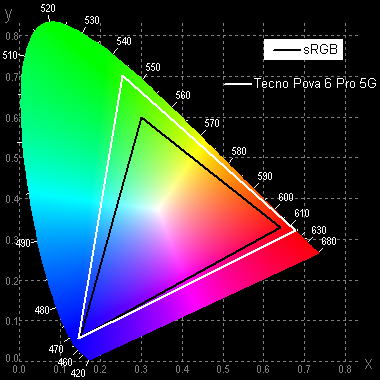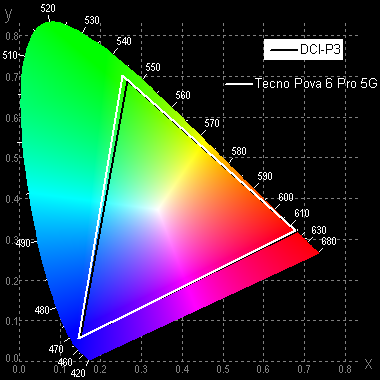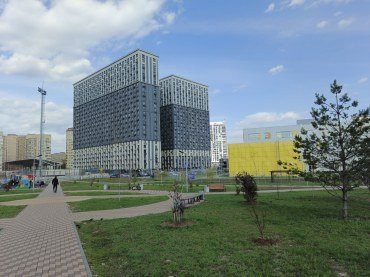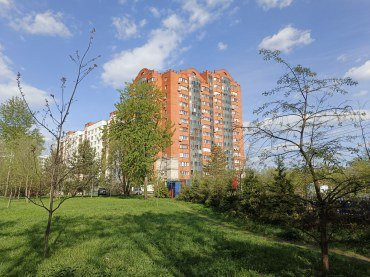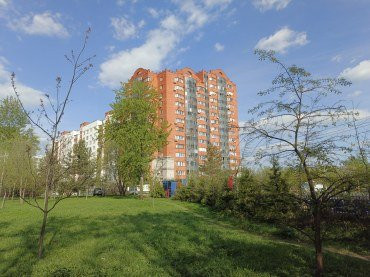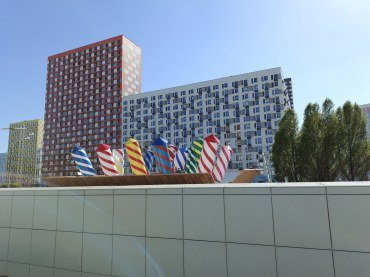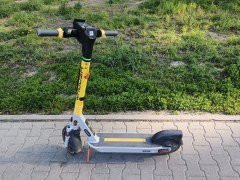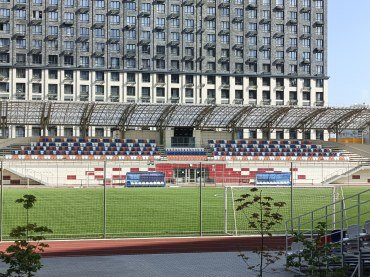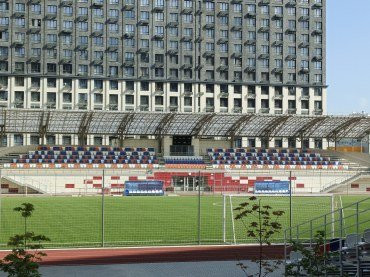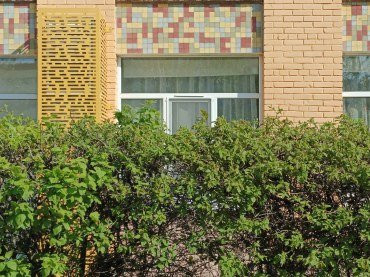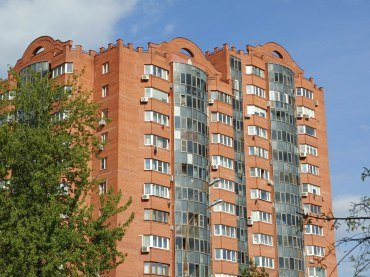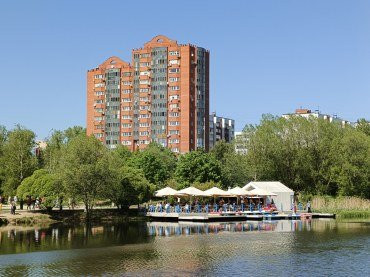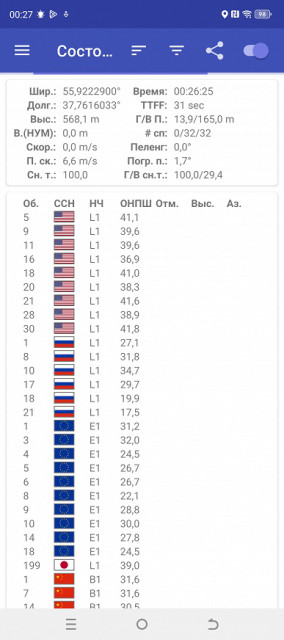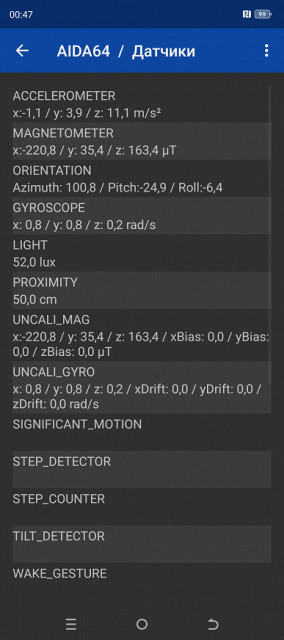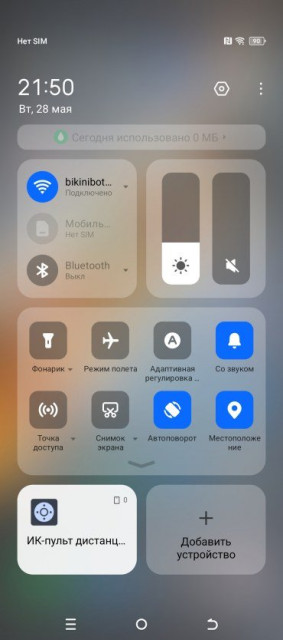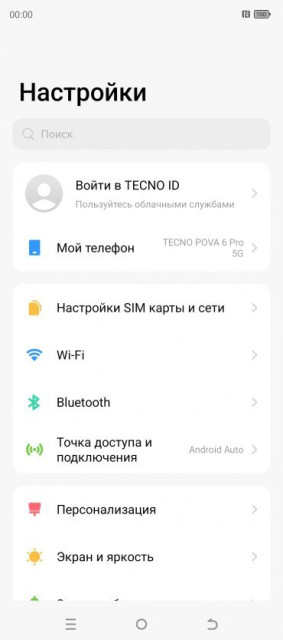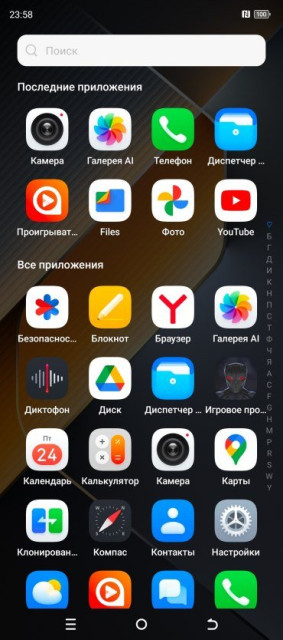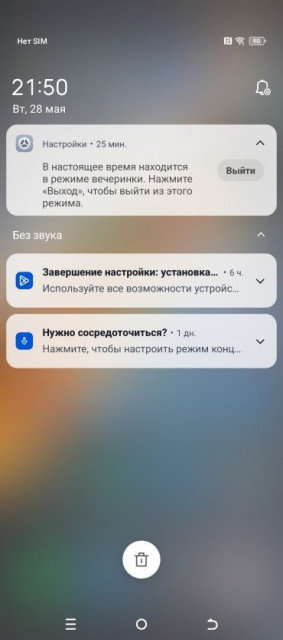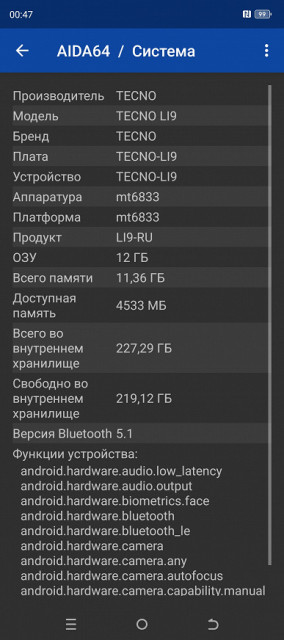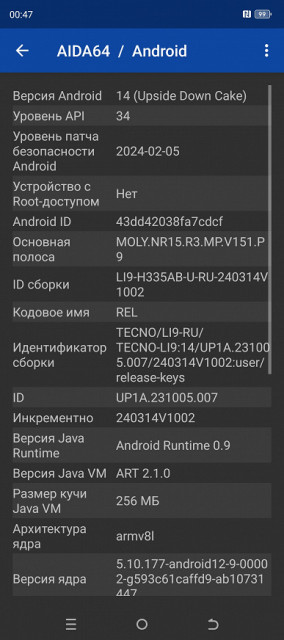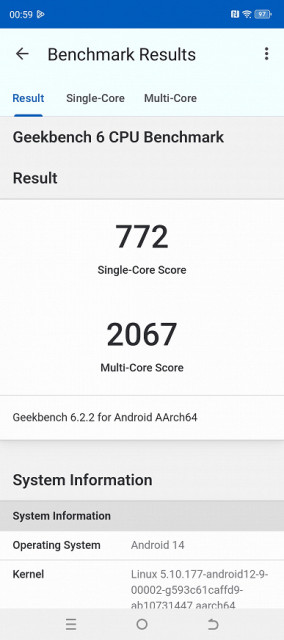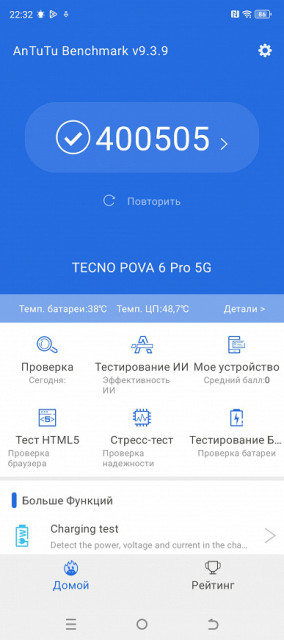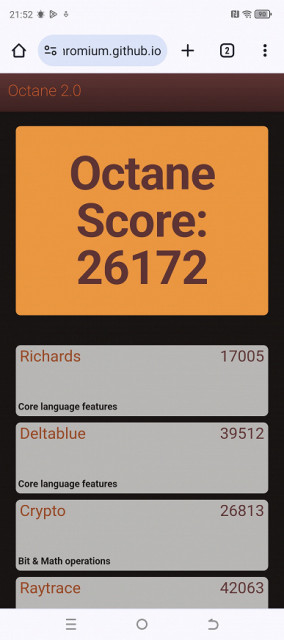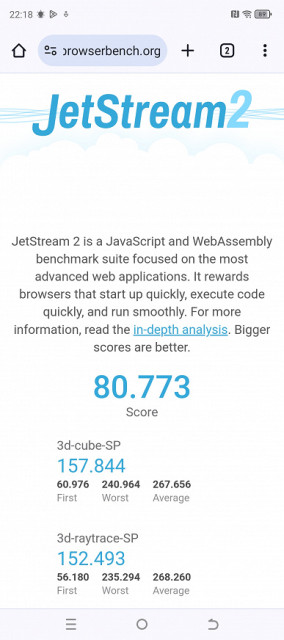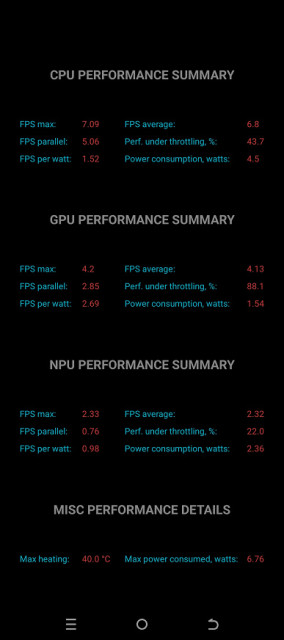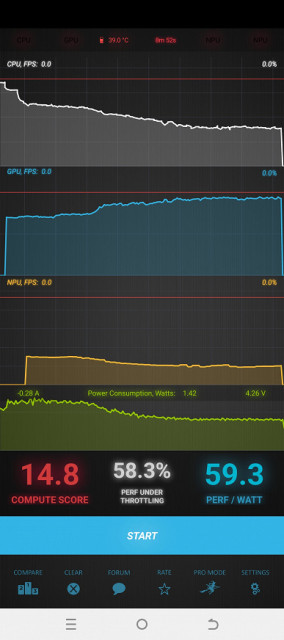This spring, the Tecno brand, part of the Transsion concern, presented an updated line of bright Pova 6 smartphones. This series includes several models: in addition to the “basic” Pova 6, there is the younger Pova 6 Neo, which we have already tested, and the older, most technically advanced the version is Pova 6 Pro 5G, which we will study this time.
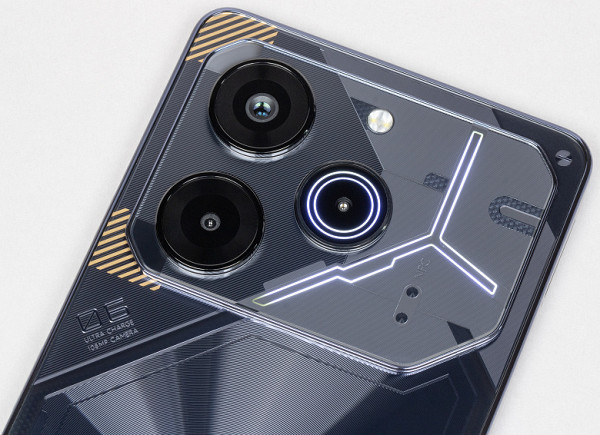
Key Features of Tecno Pova 6 Pro 5G (Model LI9)
- SoC Mediatek Dimensity 6080, 8 processor cores (2×Cortex-A76 @2.4 GHz + 6×Cortex-A55 @2.0 GHz)
- GPU Mali-G57 MC2
- Operating system Android 14, HiOS 14
- Touch display AMOLED, 6.78″, 1080×2436, 20:9, 393 ppi, 120 Hz
- RAM 8/12 GB, internal memory 256 GB
- microSD support (independent slot)
- Nano-SIM support (2 pcs.)
- Networks 2G GSM, 3G WCDMA, 4G LTE, 5G
- GPS, Glonass, BDS, Galileo, QZSS
- Wi-Fi 5 (2.4 and 5 GHz)
- Bluetooth 5.3, A2DP
- NFC
- IR port
- USB 2.0 Type-C, USB OTG
- 3.5mm headphone audio output
- Cameras 108 MP + 2 MP, video 1440p@30 fps, 1080p@60 fps
- Front camera 32 MP
- Proximity and lighting sensors, magnetic field, accelerometer, gyroscope
- Fingerprint scanner (under the screen)
- Battery 6000 mAh, charging 70 W
- Dimensions 166×76×7.9 mm
- Weight 198 g
Appearance and ease of use
The Tecno Pova 6 Pro 5G smartphone comes in a hard cardboard packaging with a discreet design.
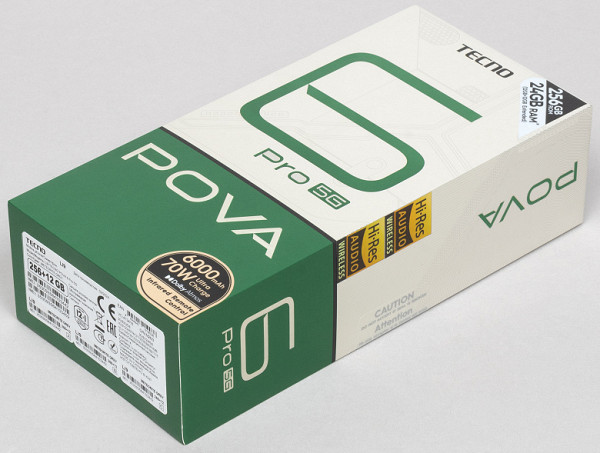
The relatively rich kit includes a 70 W power supply, a connecting cable and a protective case.

Tecno Pova 6 Pro 5G continues to use the technogenic style of futuristic Turbo Mecha robots in its design, since the series was created as a gaming one. The overall look, with straight, angular features, without streamlined shapes or curved front glass, is complemented by an intricate texture on the back panel.
The materials are quite ordinary: the side frame is made of matte plastic with a metallic effect, and the back panel is covered with transparent smooth plastic, under which a man-made pattern is visible.

This entire design is decorated with an LED panel with intersecting light strips that can “blink”, “breathe” and shimmer with light depending on the scenarios and operating modes. These modes can be configured manually. The panel also synchronizes with the music player, indicates the battery charging process, alerts and other events.

The smartphone is quite large, but not too heavy. The case is practical and can easily be used without a protective case. However, the included case is not the usual clear flexible silicone version, but is made with thick opaque sides and a flexible transparent back. It looks very good, organically complementing the design of the device.
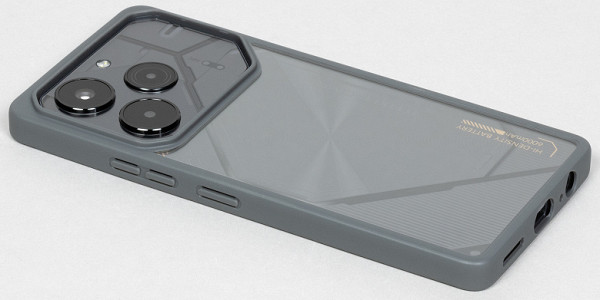
The side buttons are wide enough, but with too short a stroke. They are located on one side directly under the fingers.
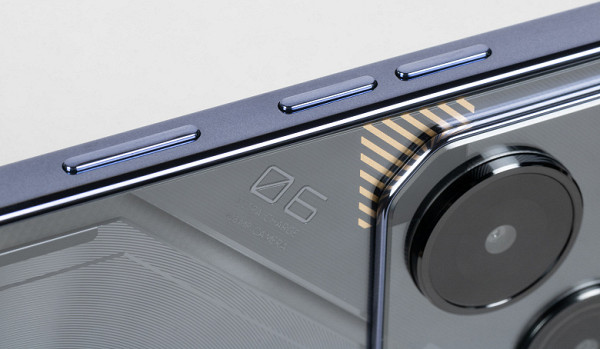
A single front camera eye is installed behind a circular cutout in the screen matrix in the center of the top edge.
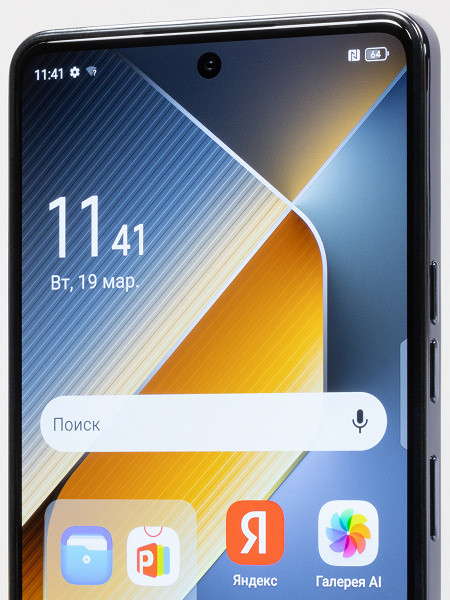
The fingerprint scanner is located under the bottom of the screen glass. This is an optical scanner that works quite quickly, but is still less convenient and slow compared to the side button scanner. In addition, it is located quite close to the bottom edge, so you will have to grab the smartphone or use your second hand to unlock it.
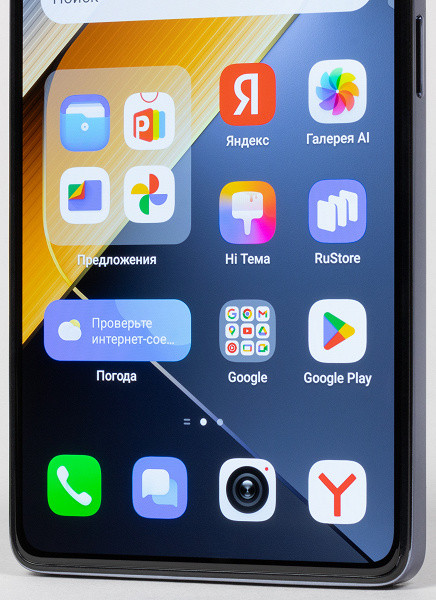
The sliding tray can accommodate two Nano-SIM cards and a microSD memory card at the same time.
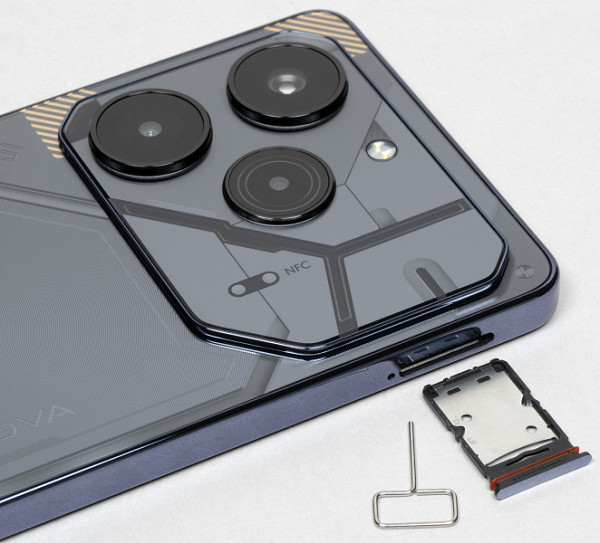
At the bottom there is a speaker, a microphone and a USB Type-C connector. The 3.5 mm audio output is not forgotten either.

The upper end is given over to an additional microphone and a second speaker; there is also an IR port peephole.

The device is available in two colors — dark gray and emerald green. The case is protected from moisture and dust according to the IP53 standard, which protects the smartphone from water splashes and allows you to use the touch display with wet fingers in the rain, but does not protect against complete immersion in water.
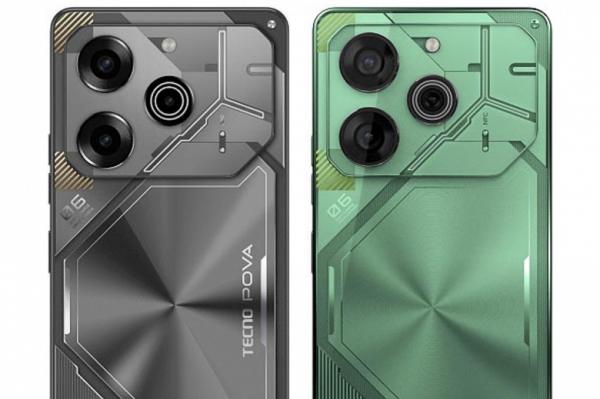
Screen
The Tecno Pova 6 Pro 5G smartphone features a 6.78-inch AMOLED display with a resolution of 1080×2436 (20:9) and a flat protective glass. The physical dimensions of the screen are 70x157 mm, and the pixel density is 393 ppi. The frames around the screen are 3mm wide on the sides and 4mm wide at the top and bottom. The display supports a 120Hz refresh rate.
The front surface of the screen is made of glass with a mirror-smooth surface that is scratch-resistant. Thanks to good anti-glare properties, the screen copes better with reflections than the Google Nexus 7 (2013) screen. The outer side of the display has an effective oleophobic coating, which makes fingerprints easier to remove and less likely to appear than on regular glass.
When manually adjusting the brightness and displaying the white field on the entire screen, the maximum brightness is approximately 520 cd/m² under normal conditions. In bright light, when the high brightness mode is turned on, it can reach 960 cd/m². In any case, the maximum screen brightness is very high. The smaller the area of white on the screen, the brighter it glows, making the actual maximum brightness of the white areas even higher. Thanks to its excellent anti-glare properties, screen readability in the sun remains at an acceptable level. A dark theme not only saves battery power, but also improves screen readability in bright conditions. The minimum brightness with manual settings is 2 cd/m², which allows you to comfortably use the device in complete darkness.
Automatic brightness adjustment is carried out using a light sensor located on the front panel next to the front speaker grille. In automatic mode, the screen brightness changes depending on the ambient lighting conditions. In the complete absence of light, auto brightness reduces the brightness to 2 cd/m² (very dark), in an office with artificial lighting (approximately 550 lux) it sets it to 140 cd/m² (normal), and in direct sunlight it increases to 960 cd/m² (maximum ). However, the auto-brightness setting is not always satisfactory, since after changing external conditions the brightness returns to its previous values. Auto-adjustment works more or less adequately, but does not allow the user to customize it to his preferences.
At high and medium brightness levels there is significant modulation at approximately 60, 90 or 120 Hz. The figures below show brightness (on the vertical axis) versus time (on the horizontal axis) for various brightness values in 60 Hz mode:
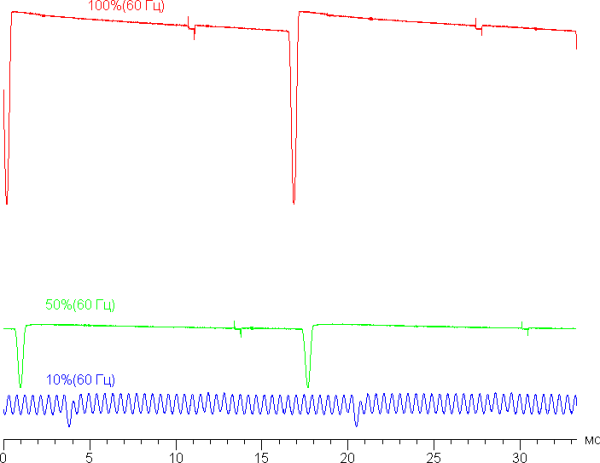
At high and medium brightness levels, the modulation frequency is 60 Hz, with low duty cycle and varying modulation phase across the entire screen area, eliminating visible flicker. With a significant decrease in brightness, modulation appears at a higher frequency — 2.16 kHz, but there is still no visible flicker.
In the screen settings, you can enable modes with a refresh rate of 90 and 120 Hz.
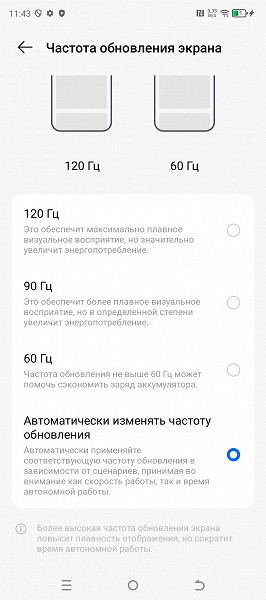
In 90 and 120 Hz modes, scrolling smoothness increases noticeably. Let's see if this changes the nature of the modulation. 90Hz mode:

At high and medium brightness levels, the modulation frequency increased to 90 Hz, maintaining the same character as at the 60 Hz refresh rate. At low brightness levels, modulation remains unchanged, eliminating visible flicker.
In 120Hz mode:

At high and medium brightness levels, the modulation frequency increased to 120 Hz, maintaining the same character as at the 60 Hz refresh rate. At low brightness levels, modulation remains unchanged, eliminating visible flicker.
The screen uses an AMOLED (active matrix organic light emitting diode) matrix. A full-color image is formed using subpixels of three colors — red ®, green (G) and blue (B), but the number of red and blue subpixels is half as large, which corresponds to the RGBG scheme. This is confirmed by microphotography.

The fragment above shows 4 green subpixels, 2 red (4 halves) and 2 blue (1 whole and 4 quarters). By repeating such fragments, you can cover the entire screen without breaks or overlaps. For such matrices, Samsung uses the term PenTile RGBG. The screen resolution is calculated by the manufacturer based on the number of green subpixels, which means that the resolution for the other two colors will be lower. Although there is some jagged edge contrast and other artifacts, due to the high resolution they have minimal impact on image quality.
The screen has excellent viewing angles. White color takes on a slight blue-green tint at a wide angle of deflection, but black color remains deep black at any angle. The contrast in this case is so high that the contrast parameter is simply not applicable. For comparison, here are photographs in which the same images are displayed on the screens of a smartphone and another device (Nexus 7). The brightness of the screens is initially set at approximately 200 cd/m², and the color balance on the camera is set to 6500 K.
A white field is displayed perpendicular to the screens:
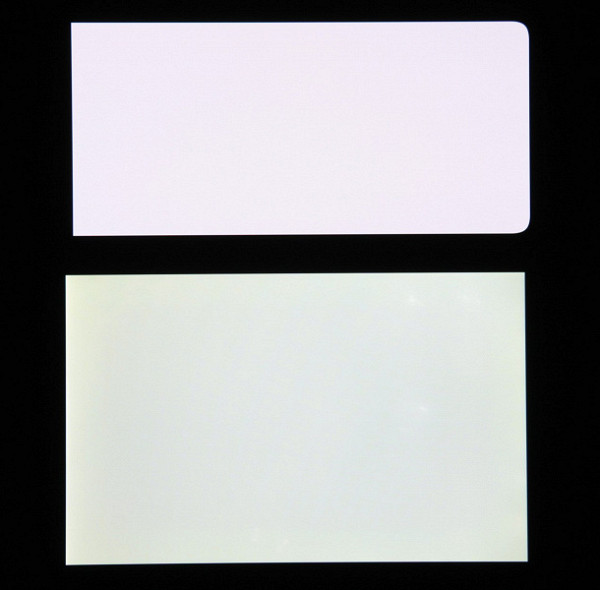
Note the good uniformity of brightness and color tone of the white field.
And test picture (Original color profile):

Colors on the smartphone screen look oversaturated (especially noticeable on tomatoes, bananas, napkins and face shades), and there is a noticeable difference in color balance. It should be noted that the photograph cannot be a completely reliable source of information about the quality of color reproduction and is presented only as a conditional illustration. In particular, the pronounced reddish tint on white and gray fields, which is noticeable in photographs of the smartphone screen, is visually absent when viewed directly, as confirmed by hardware tests using a spectrophotometer. The reason is that the spectral sensitivity of the camera sensor does not exactly match the sensitivity of human vision.
The photo above was taken after selecting the «Original Color» profile in the screen settings. There are two color rendering profiles available.

When choosing the first, Vivid Colors, the colors are even more oversaturated and unnatural:

This effect is achieved due to a slight expansion of the color gamut and an increase in color contrast. Additionally, you can adjust the shade (Cool color — Warm color).
The brightness at an angle for both screens decreases noticeably, but in the case of a smartphone the drop in brightness is much less pronounced. As a result, with formally the same brightness, the screen of this smartphone visually looks much brighter (compared to LCD screens), since the screen of a mobile device is often viewed at an angle.
Switching the state of the matrix elements occurs almost instantly, but at the turn-on edge there may be a step with a width of approximately 17 ms (which corresponds to a screen refresh rate of approximately 60 Hz), or approximately 11 ms (90 Hz), or approximately 8 ms (120 Hz). For example, this is what the dependence of brightness on time looks like when moving from black to white:

In some conditions, the presence of such a step can lead to plumes trailing behind moving objects.
The gamma curve, constructed using 32 points with equal intervals based on the numerical value of the shade of gray, did not reveal any dips in either shadows or highlights. The power function fit exponent is 2.34, which is slightly higher than the standard value of 2.2, so the image appears slightly darkened, while the actual gamma curve deviates little from the power function:
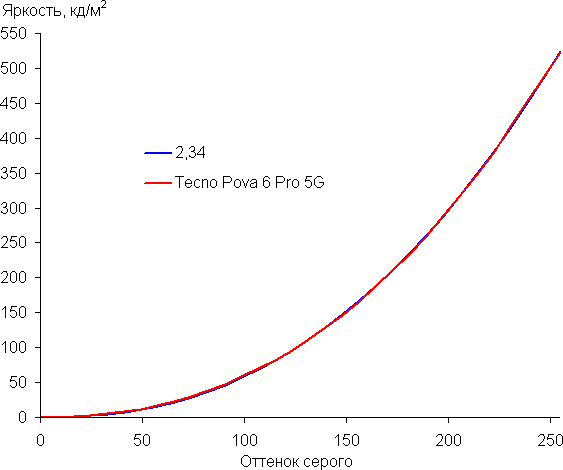
Let us recall that in the case of OLED screens, the brightness of image fragments dynamically changes depending on the nature of the displayed image — it decreases slightly for generally light images. As a result, the resulting dependence of brightness on hue (gamma curve) may differ slightly from the gamma curve of a static image, since the measurements were carried out with sequential output of shades of gray almost over the entire screen.
The color gamut, even in the case of the «Original Color» profile, is much wider than sRGB and very close to the DCI-P3 space:
In the case of the Vivid colors profile, the color gamut is slightly wider than DCI-P3:
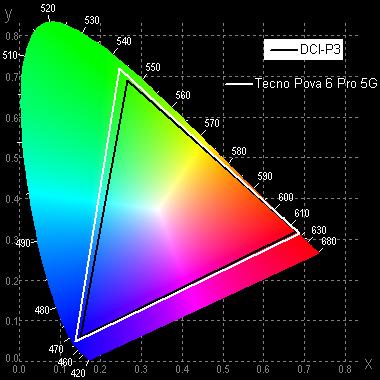
In this case, the component spectra (that is, the spectra of pure red, green and blue) are very well separated:
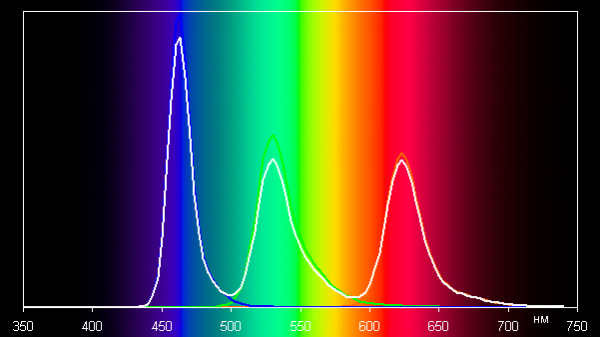
In the case of the Original color profile there is already a slight cross-mixing:

The balance of shades on the gray scale is a compromise, since the color temperature is noticeably higher than the standard 6500 K, but the deviation from the blackbody spectrum (ΔE) is less than 10 units, which is a good indicator for a consumer device. At the same time, color temperature and ΔE change slightly from hue to hue, which has a positive effect on the visual assessment of color balance. The darkest areas of the gray scale can be ignored, since color balance there is not very important, and the error in measuring color characteristics at low brightness is high.
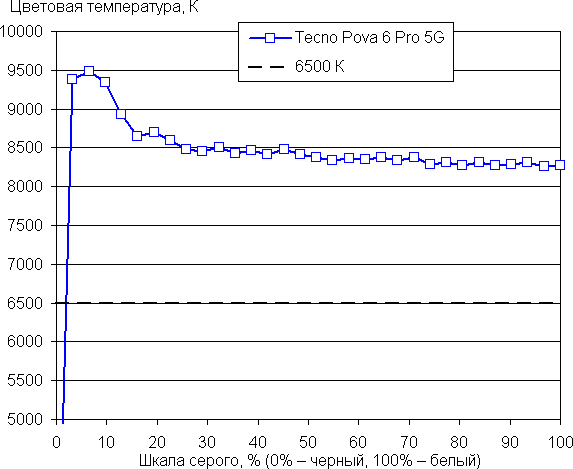
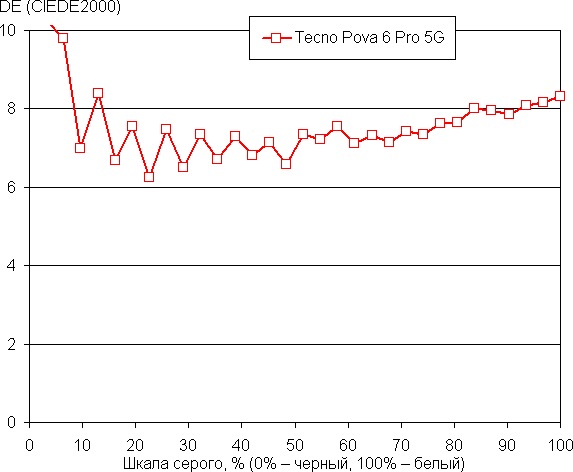
Adjusting the hue in the direction of lowering the color temperature leads to a significant increase in ΔE, so there is no point in making such a correction.
Of course, there is an “Eye Protection Mode” setting that reduces the intensity of the blue component. Bright light can disrupt the circadian rhythm, but this can be resolved by reducing the brightness to a comfortable level, without the need to distort the color balance, reducing the contribution of blue.

This setting is useless for color balance correction, since even with minimal correction the color temperature is below the standard 6500 K (about 5400 K). It's best to leave everything at default as this ensures maximum brightness.
This machine probably doesn't support DisplayPort Alt Mode for USB Type-C, which means it won't be able to output video and audio to an external device via the USB port.
Let's summarize. The screen has a very high maximum brightness (up to 960 cd/m² and exactly 520 cd/m²) and excellent anti-glare properties, which allows you to comfortably use the device outdoors even on a sunny day. In complete darkness, the brightness can be reduced to a comfortable level (up to 2 cd/m²). The automatic brightness adjustment mode works quite adequately, although it does not allow the user to fine-tune it to suit their preferences. The advantages of the screen include the absence of visible flicker, an effective oleophobic coating and modes with an increased refresh rate of up to 90 or 120 Hz. OLED screens also have their overall advantages: true blacks (without reflections), good white field uniformity, and less brightness drop when viewed from an angle compared to LCD screens. The disadvantages include too wide a color gamut, which often leads to distorted and unnatural colors when watching videos and photos. However, overall the screen quality is high.
Camera
The Tecno Pova 6 Pro 5G smartphone is equipped with a single main camera with a resolution of 108 MP and an f/1.9 lens. It uses high-quality PDAF phase detection autofocus, but does not have an optical stabilizer.
The camera is set to shoot at 12MP by default with 9-in-1 pixel binning, but a full 108MP shooting mode is also available. Full resolution photos capture more detail, but may look less contrasty and a little blurry due to the camera not always making full use of all 108 megapixels. However, such photographs may contain noise and color artifacts when viewed enlarged. Photos taken and processed in 12-megapixel mode appear brighter and more contrasty, with more depth and color saturation, without adding obvious edge sharpening. In general, if you do not plan further processing in photo editors, it is recommended to use the 12-megapixel mode for more impressive photos.
The camera's shooting quality is quite good, especially for a smartphone in this price segment. The detailing is slightly less than ideal due to the peculiarities of software processing. Sometimes, when increasing brightness, the program may not handle contrast accurately enough, which leads to loss of detail in the shadows. You can also notice some shortcomings in the quality of the optics, such as slight blurring across the field of the frame, especially at the edges. In general, the camera is not a flagship, but for its class it provides quite decent quality.
Night shooting results remain acceptable. Detail is noticeably reduced, especially on uniform surfaces where noise is smoothed out, but there are noticeable problems on high-contrast objects and their surroundings. However, the processing is not too aggressive and these photographs are quite suitable for use as miniatures, especially given adequate exposure.
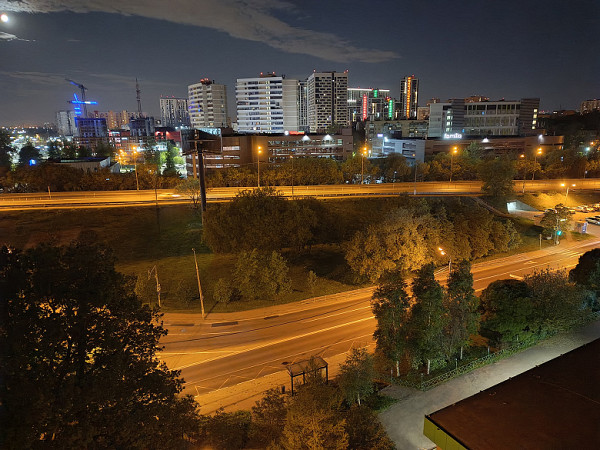
In this case, the smartphone uses only digital zoom, but when using 3x zoom, the 108-megapixel photo is cropped and then carefully processed. These images can be used immediately without the need for additional processing in a photo editor. Although there is a slight loss of detail and noise, the result is still very decent and certainly not inferior to basic modules with 2x optical zoom. It's worth noting, however, that 3x digital zoom photos at 108 megapixels no longer have much value.
This smartphone allows you to shoot videos with a maximum resolution of 1440p at 30 frames per second. The 60 fps mode is available at 1080p resolution, but in both cases there is noticeable image jerking, and electronic stabilization only works in 1080p mode at 30 fps. However, the quality of stabilization leaves much to be desired: when shooting on the move, the image is subject to twitching and a “jelly” effect. It is best to use this smartphone for video shooting in a static position. Video at 1440p resolution is bright, clear and has good detail, although it can be a little overexposed. The sound is recorded perfectly.
The selfie camera is also a good unit with excellent detail and sharpness. However, sometimes there are overexposures and some problems with color rendering.

Telephone and communications
The network capabilities of the Tecno Pova 6 Pro 5G smartphone are impressive. Most 4G and 5G mobile network bands, two Wi-Fi 5 bands and Bluetooth 5.3 are supported, and there is also NFC. Our version of the smartphone does not support 5G and e-SIM networks. In the conditions of the Moscow city limits, the device demonstrates reliable operation in wireless networks, does not lose connection and quickly restores it after a break. All the necessary built-in sensors, including the gyroscope, work properly.
The single-channel satellite navigation module supports GPS, Glonass, BDS, Galileo and QZSS. The first satellites are quickly detected during a cold start, and the positioning accuracy leaves a good impression.
The volume of the speaker is quite high, the voice of the interlocutor is clearly audible. The vibration alert is not too sharp, but pleasant thanks to the installed linear vibration motor.
Software and multimedia
The Tecno Pova 6 Pro 5G smartphone runs on the Android 14 operating system with a custom HiOS 14 skin. The skin is clean, neat and well translated into various languages. Unlike some other Chinese manufacturers, there are no intrusive pop-up ads. The Always On screen function is limited: it is activated only by touch, and does not work all the time. There is also a Dynamic Port feature, popular among Chinese manufacturers, which creates a dynamic zone around the front camera to display current information. The notification shade is divided into two parts for ease of use. The official Google Play app store and access to all Google services are available on the device.
The smartphone supports stereo sound with a dedicated loudspeaker at the top end, which provides full sound. The sound characteristics are impressive: high volume, clarity and richness of the sound at the level. There is also a 3.5mm audio output for wired headphones, which adds convenience. Using Dolby Atmos presets, you can customize the sound for different situations.
Performance
The Tecno Pova 6 Pro 5G smartphone is powered by an octa-core Mediatek Dimensity 6080 processor with Mali-G57 MC2 GPU. It has 8 or 12 GB of RAM and 256 GB of internal storage, expandable via memory cards. Connection of external devices via the USB Type-C port in USB OTG mode is supported.
This platform was announced in June 2023 and is manufactured using the 6 nm process technology. Despite the fact that it belongs to last year's solutions, performance indicators are below average, with a score of about 400 thousand points in AnTuTu. The smartphone is capable of efficiently performing everyday tasks and providing a smooth interface. However, its resources are no longer sufficient for shooting 4K video at 60 frames per second. Games can be played, but settings will need to be lowered to achieve smooth performance.
Testing in comprehensive tests AnTuTu and GeekBench:
To make it easier to summarize all the smartphone testing results, we have compiled tables that include several other devices from different segments, which were also tested on the latest versions of popular benchmarks. This allows you to clearly compare the obtained numerical indicators. However, it is worth noting that due to the limitations of a single comparison, we cannot include results from different versions of benchmarks, which leaves out many worthy and relevant models tested on previous versions of benchmark programs.
| Tecno Pova 6 Pro (Mediatek Dimensity 6080) | Infinix Note 40 Pro (Mediatek Helio G99 Ultimate) | Huawei nova 12s (Qualcomm Snapdragon 778G) | Realme 12 Pro+ (Qualcomm Snapdragon 7s Gen2) | Redmi Note 13 Pro+ (Mediatek Dimensity 7200 Ultra) | |
|---|---|---|---|---|---|
| AnTuTu (v9.x) (bigger is better) | 400505 | 392027 | 546957 | 576685 | 669583 |
| GeekBench 6 (bigger is better) | 772/2067 | 737/2042 | 996/2453 | 894/2801 | 1126/2643 |
Testing the graphics subsystem in GFXBenchmark gaming tests:
| Tecno Pova 6 Pro (Mediatek Dimensity 6080) | Infinix Note 40 Pro (Mediatek Helio G99 Ultimate) | Huawei nova 12s (Qualcomm Snapdragon 778G) | Realme 12 Pro+ (Qualcomm Snapdragon 7s Gen2) | Redmi Note 13 Pro+ (Mediatek Dimensity 7200 Ultra) | |
|---|---|---|---|---|---|
| GFXBenchmark Aztec Ruins OpenGL (Onscreen, fps) | 17 | 18 | 34 | 35 | 50 |
| GFXBenchmark Aztec Ruins Vulkan (Onscreen, fps) | 15 | 16 | 38 | 39 | 55 |
| GFXBenchmark Car Chase ES 3.1 (1080p Offscreen, fps) | 17 | 17 | 33 | 30 | 43 |
| GFXBenchmark Manhattan ES 3.1 (1080p Offscreen, fps) | 28 | 28 | 56 | 54 | 74 |
| GFXBenchmark T-Rex (1080p Offscreen, fps) | 69 | 68 | 133 | 122 | 191 |
Testing in browser cross-platform tests:
| Tecno Pova 6 Pro (Mediatek Dimensity 6080) | Infinix Note 40 Pro (Mediatek Helio G99 Ultimate) | Huawei nova 12s (Qualcomm Snapdragon 778G) | Realme 12 Pro+ (Qualcomm Snapdragon 7s Gen2) | Redmi Note 13 Pro+ (Mediatek Dimensity 7200 Ultra) | |
|---|---|---|---|---|---|
| Google Octane 2 (bigger is better) | 26172 | 24105 | 24923 | 30529 | 39276 |
| JetStream (bigger is better) | 81 | 76 | 67 | 85 | 79 |
Memory speed test results:
Heat
We test for performance degradation when heating using the Burnout Benchmark program, which allows you to load the CPU, GPU and NPU:
| Stress on | Heating performance, as a percentage of maximum |
|---|---|
| CPU | 44% |
| GPU | 88% |
| NPU | 22% |
Battery life
The smartphone is equipped with a high-capacity 6000 mAh battery, but in tests it showed only a sufficient level of autonomy.
Testing was carried out at standard power consumption levels without using the power saving features, although they are available on the device. Test conditions included a minimum comfortable brightness level (approximately 100 cd/m²). During the tests, the following scenarios were used: continuous reading in the Moon+ Reader application using the standard light theme, continuous viewing of video in HD quality (720p) and the game Injustice 2 with automatic graphics settings.
| Battery capacity | Reading mode | Video mode | 3D gaming mode | |
|---|---|---|---|---|
| Tecno Pova 6 Pro 5G | 6000 mAh | 22 h. 00 m. | 20 h. 00 m. | 7 h. 00 m. |
| Infinix Note 40 Pro | 5000 mAh | 18 h. 00 m. | 15 h. 00 m. | 6 h. 00 m. |
| Tecno Spark 20 Pro+ | 5000 mAh | 18 h. 00 m. | 14 h. 00 m. | 6 h. 00 m. |
| Vivo V30 | 5000 mAh | 23 h. 00 m. | 21 h. 00 m. | 8 h. 00 m. |
| Vivo V29 | 4600 mAh | 21 h. 00 m. | 19 h. 00 m. | 8 h. 30 m. |
| Infinix GT 10 Pro | 5000 mAh | 20 h. 30 m. | 18 h. 00 m. | 8 h. 30 m. |
| Tecno Camon 20 Pro 5G | 5000 mAh | 19 h. 00 m. | 16 h. 00 m. | 7 h. 00 m. |
| Vivo V27 | 4600 mAh | 25 h. 00 m. | 19 h. 00 m. | 7 h. 00 m. |
All these data represent the maximum possible values obtained under «ideal» conditions, including no SIM cards installed. Any changes in conditions of use will likely reduce these results.
The smartphone charges from the included 70 W mains charger in 50 minutes. Wireless charging is not supported.
Bottom line
This smartphone attracts attention with its interesting appearance, which, no doubt, will be in demand among young people. It is equipped with a high-quality AMOLED screen, supports stereo sound and all necessary network standards. Technical characteristics are at an average level, but sufficient for everyday use. The camera deserves praise. In general, the smartphone fully meets its functional objectives, is intended for a wide audience and represents an adequate offer in the mid-price segment.

